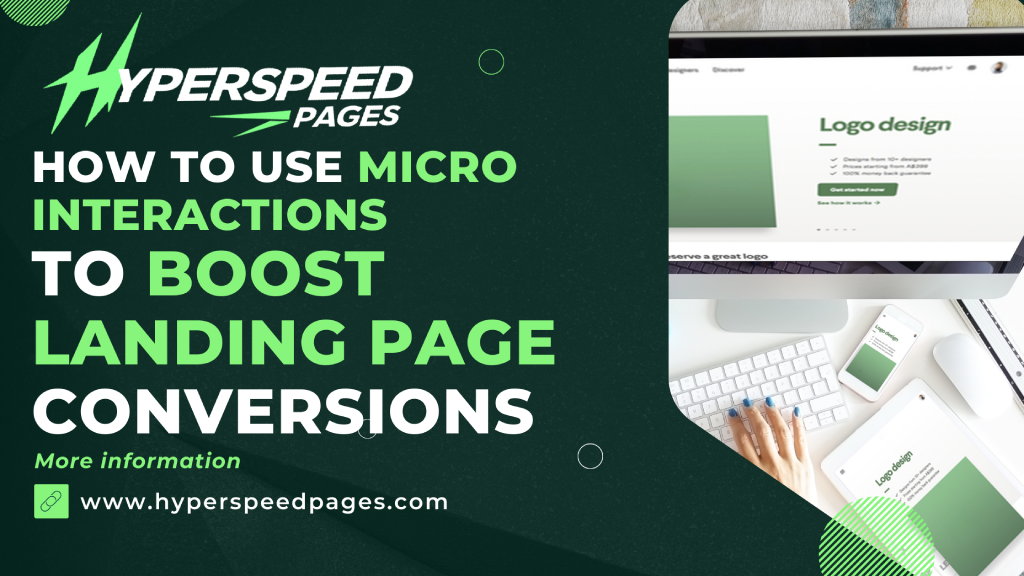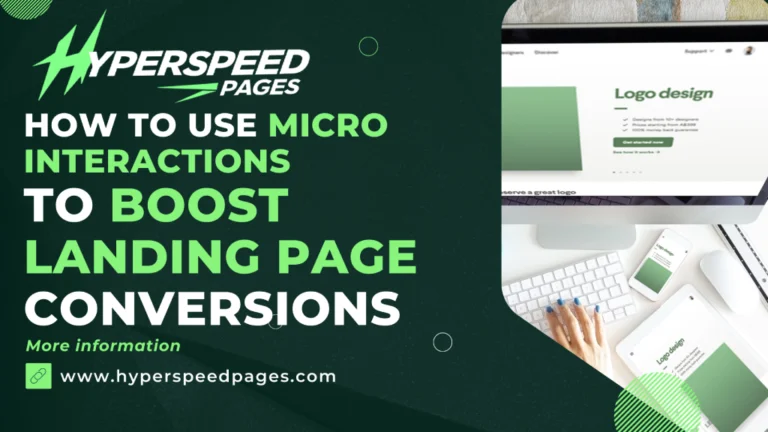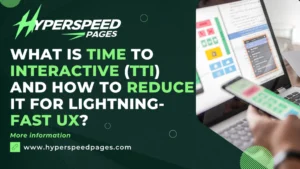
The Silent Conversion Killers on Your Landing Page (And How Microinteractions Can Save You)
You’ve poured hours, maybe weeks, into crafting the perfect event landing page. The copy is compelling, the offer is irresistible, the visuals are stunning. Yet, the conversion rates aren’t meeting expectations. Sound familiar? Often, the culprits aren’t the big-picture elements, but the tiny, almost invisible details – or lack thereof. Welcome to the critical world of microinteractions.
Did you know that 88% of online consumers are less likely to return to a website after a bad user experience (HubSpot)? Meanwhile, strategically designed micro-interactions can increase engagement by up to 400% (Adobe).
Micro-interactions, those tiny, subtle animations and feedback loops—are the unsung heroes of high-converting landing pages. When done right, they reduce friction, guide users, and create emotional connections, ultimately boosting conversions.
Research from the Nielsen Norman Group shows that well-executed micro interactions can increase user engagement by up to 20%, while a 2024 HubSpot study pegged their impact on conversions at a potential 15% uplift. So, how do you harness these micro-moments to turn visitors into leads, customers, or subscribers?
What Exactly ARE Microinteractions?
Microinteractions are far more than just aesthetic fluff. When strategically designed and implemented, they become powerful psychological tools that can:
- Reduce friction in user journeys (especially forms!).
- Provide crucial feedback and build user confidence.
- Guide attention towards key elements (like your CTA).
- Increase perceived value and professionalism.
- Boost engagement and keep users on the page longer.
- Ultimately, drive significantly higher real estate landing page conversions.
Coined by renowned UX designer Dan Saffer in his book “Microinteractions”, these are defined as contained product moments that revolve around a single use case. Think of them as tiny conversations between the user and the interface.
Every effective microinteraction consists of four essential components:
- Trigger: Initiates the microinteraction. This can be user-initiated (e.g., clicking a button, hovering over an element, scrolling, typing in a field) or system-initiated (e.g., loading completion, receiving a notification, meeting a predefined condition). On a landing page, triggers are often clicks on CTAs, hover over informational icons, form field interactions, or page scroll events.
- Rules: Define what happens during the microinteraction once triggered. They determine the sequence, logic, and constraints of the feedback. For example, a rule might state: “When the user types an invalid email format, display a red border and an error message below the field.”
- Feedback: The visible (or sometimes audible/haptic) response that communicates the rules have been engaged and something is happening (or has happened). This is the core of the microinteraction’s perceived effect – the animation, the color change, the message, the sound. Feedback tells the user their action was recognized, explains the outcome, and guides next steps.
- Loops & Modes: Determine the meta-rules of the microinteraction.
- Loops: Define how long the microinteraction lasts and whether it repeats (e.g., a loading animation loops until content is ready).
- Modes: Define situations that might change the normal operation of the microinteraction (e.g., clicking “edit” might change the mode of a displayed piece of information, allowing different interactions). Modes are less common in simple landing page microinteractions but can appear in multi-step forms or configurators.
Examples of Micro Interactions on Landing Pages
- Hover effects on CTAs
- Animated loading indicators
- Form field validations
- Progress indicators
- Button feedback (e.g., color shift or bounce)
- Scroll-triggered animations
- Tooltip hints or popovers
The Psychology Behind Micro Interactions
Humans are wired to respond to feedback. Micro interactions tap into this primal need for confirmation, guidance, and even play. When a user gets subtle cues like a bounce, shake, or tooltip, their brain interprets it as “I’m doing it right”—or, at least, “Something’s happening.”
This kind of positive reinforcement enhances usability and lowers friction—key components in high-converting landing pages.
Here’s how they affect user behavior:
- Instant Gratification: Real-time feedback triggers dopamine release.
- Flow State Engagement: Subtle transitions keep the brain focused and immersed.
- Error Prevention: Immediate validations prevent form drop-offs.
- Delight & Memorability: Playful animations can make your brand more lovable and memorable.
Micro Interactions & Conversion Rate Optimization (CRO)
Landing pages are built to convert—whether that’s signups, downloads, sales, or demo bookings. Micro interactions can be leveraged at key touchpoints to guide users, reduce bounce rates, and nudge them over the line.
How to Implement Micro Interactions (With Examples)
Here’s how to strategically place micro interactions on your landing page:
1. CTA Buttons that React
Why it works: A slight animation (like a zoom-in or bounce) on hover or click draws attention and reassures the user that their action is being processed.
Best practices:
- Use easing animations, not jarring transitions.
- Combine color shifts with tactile motion.
- Avoid overdoing it too much animation can seem spammy.
Example: Shopify’s landing pages feature smooth button transitions that provide immediate feedback.
2. Inline Form Field Validation
Why it works: Instead of making users wait until form submission to fix errors, show real-time feedback like green check marks or red outlines.
Best practices:
- Keep it simple and non-intrusive.
- Pair icons with clear messaging (“Password too weak”).
- Use microcopy to guide (“Must contain a number”).
Example: Mailchimp uses progressive field hints and inline validation to make signup frictionless.
3. Progress Indicators & Loading Animations
Why it works: Progress bars or spinners reduce abandonment by setting expectations and keeping users visually engaged.
Best practices:
- Show actual progress or use engaging looped animations.
- Add personality with brand colors or custom graphics.
Example: HubSpot’s demo request form shows step progress, easing users through each section.
4. Scroll-Based Animation Triggers
Why it works: Subtle animations that trigger as the user scrolls help tell a story and keep visitors engaged.
Best practices:
- Use parallax effects, fade-ins, or slide-ups.
- Ensure performance doesn’t suffer, optimize with CSS and lazy loading.
Example: Stripe’s landing pages use scroll-triggered visuals to demonstrate their product in action.
5. Success Messages & Confirmation States
Why it works: Post-conversion feedback (e.g., “Thank you!” animations or check-mark icons) makes users feel good about their action and reduces uncertainty.
Best practices:
- Reinforce value with celebratory micro interactions.
- Suggest a next step (e.g., “Check your email” or “Download here”).
Example: Notion uses celebratory checkmark animations after signup, reinforcing user momentum.
Pro Tips for Designing High-Impact Micro Interactions
- Start Small: Focus on the most important interactions first—like forms and CTAs.
- Stay Consistent: Match motion style and tone across the page.
- Test for Performance: Heavy animations can impact load speed—optimize with modern CSS and minimal JavaScript.
- A/B Test Everything: Measure the effect of micro interactions on bounce rate, time on page, and conversions.
- Be Purposeful: Every animation should serve a functional or emotional goal.
Micro Interactions and SEO: What Google Looks For
Google may not rank you for fancy animations, but user experience metrics like Core Web Vitals, bounce rate, dwell time, and conversion rates are absolutely influenced by micro interactions.
- Lower bounce rates
- Higher engagement metrics
- Improved user signals for SEO
- Better mobile usability scores
7 High-Converting Micro-Interactions (+ Data & Examples)
1. Button State Changes (Hover, Active, Success)
- Why it works: Visual feedback confirms actions.
- Example: Dropbox’s signup button changes from blue to green on hover.
- Impact: Can increase clicks by up to 15%.
2. Form Field Validation (Real-Time Feedback)
- Why it works: Reduces frustration.
- Example: Mailchimp’s password strength meter.
- Impact: Decreases form abandonment by 22%.
3. Progress Indicators (For Multi-Step Forms)
- Why it works: Motivates completion.
- Example: LinkedIn’s profile completion bar.
- Impact: Boosts conversions by 30%+ (Smashing Magazine).
4. Hover Animations (For CTAs & Cards)
- Why it works: Increases engagement.
- Example: Amazon’s “Add to Cart” button shadow effect.
- Impact: Can lift click-through rates by 8-10%.
5. Confirmation Animations (Post-Submission)
- Why it works: Reinforces success.
- Example: Duolingo’s celebratory confetti after a lesson.
- Impact: Improves retention by 12%.
6. Scroll-Triggered Animations (For Engagement)
- Why it works: Encourages exploration.
- Example: Apple’s product page fade-ins.
- Impact: Increases time on page by 20%.
7. Error Prevention (Smart Defaults & Warnings)
- Why it works: Reduces user frustration.
- Example: Gmail’s “Did you forget an attachment?” prompt.
- Impact: Lowers support queries by 40%.
Tools & Libraries to Get You Started
- Framer Motion (React animations)
- Lottie (Lightweight JSON animations)
- GSAP (Robust JavaScript animation library)
- CSS Animations (Native, fast, and lightweight)
- Hotjar / Crazy Egg (Track user reactions)
Real-World Examples of Micro Interaction Wins
- Airbnb: Their “Search” button ripples on click, confirming the action and reducing double-clicks. Result? A 12% boost in search completions.
- Duolingo: Lesson completion triggers a celebratory confetti burst, driving a 25% increase in daily retention.
- Stripe: Form fields highlight errors with a red shake, cutting abandonment by 18%.
These brands prove micro interactions aren’t just decorative, they’re data-backed conversion drivers.
Start Small, Convert Big
Micro-interactions are low-effort, high-impact tweaks that can supercharge your landing page conversions. The key? Focus on usability first, delight second.
So the next time you design or optimize a landing page, remember: It’s not just what users see. It’s what they feel. And micro interactions are how you make them feel seen, heard, and guided—step by step, click by click.
Audit your landing page. Spot the friction points. Then, weave in a micro interaction or two. Test it, tweak it, and watch your numbers climb. Got a favorite micro interaction trick? Drop it in the comments, I’d love to hear your take!




